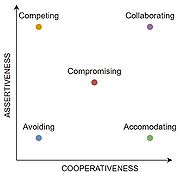Conflict Management using the Thomas-Kilmann Conflict Mode Instrument (TKI)
Contents |
Abstract
Conflicts in are common when working with other people on projects, programs, and portfolios. They should not necessarily be avoided since they can provide great value to team members and improve the final product. However, it is of great importance that team members and not least the project manager knows how to manage the conflicts appropriately to avoid that the conflict escalates and becomes inconvenient to the work [1]. (Project Management Institute, Inc. (PMI), 2021)
This article will introduce the Thomas-Kilmann conflict mode instrument (TKI), developed by Kenneth W. Thomas and Ralf H. Kilmann. The purpose of the tool is to identify a person’s most used conflict handling modes and learn to manage conflicts (Kilmann, 2011).
The article will also introduce the correlation between the Myers-Briggs Type Indicator (MBTI) assessment and the TKI assessments, meaning that certain personality types tend to use certain conflict handling modes more frequent (Kilmann & Thomas, 1975).
Big Idea
Conflicts in project management
- A general definition of conflicts
- The effects of handling conflicts appropriate and inappropriate.
The TKI assessment
- A general introduction to the tool
- Describing the two dimensions; Cooperativeness and assertiveness
- Describing the five conflict modes; Competing, collaborating, compromising, avoiding, and accommodating
- Describing the two diagonals; integrative and distributive dimension
The TKI assessment and the MBTI assessment
- Connecting the personality test (MBTI) with the conflict handling mode
Application
How to take the TKI assessment
Implementation of TKI in conflict management
- From assessment to effective behavior (5 Steps)
Examples
- Positive and negative ways of using the five handling modes
Limitations
- Design of the assessment – the social desirability response bias
Annotated bibliography
Cite error:
<ref> tags exist, but no <references/> tag was found
